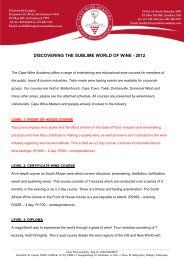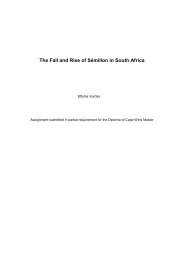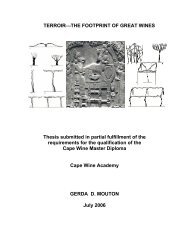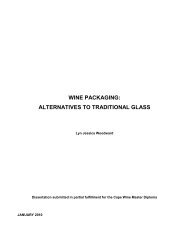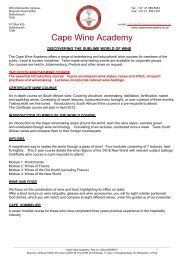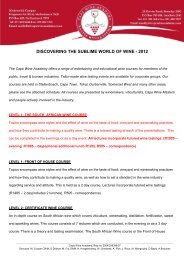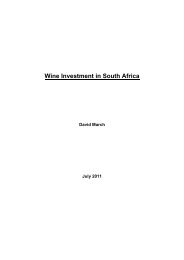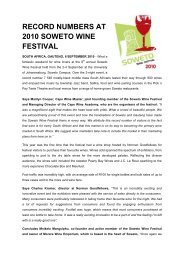micro-oxygenation in contemporary winemaking - Cape Wine ...
micro-oxygenation in contemporary winemaking - Cape Wine ...
micro-oxygenation in contemporary winemaking - Cape Wine ...
Create successful ePaper yourself
Turn your PDF publications into a flip-book with our unique Google optimized e-Paper software.
Micro-<strong>oxygenation</strong> <strong>in</strong> Contemporary W<strong>in</strong>emak<strong>in</strong>gAs shown <strong>in</strong> Figure 18 the acetaldehyde produced through coupled phenolic oxidationreactions is activated to the carbocation form and then reacts with tann<strong>in</strong> at C6 or C8. Thenew carbocation attacks the anthocyan<strong>in</strong> at C8 result<strong>in</strong>g <strong>in</strong> an anthocyan<strong>in</strong>-tann<strong>in</strong> complexjo<strong>in</strong>ed by an ethyl bridge (Wildenradt and S<strong>in</strong>gleton, 1974; Timberlake and Bridle, 1976).The result<strong>in</strong>g compound is stabilised by deprotonation to form a violet coloured qu<strong>in</strong>oidalbase.HOTann<strong>in</strong>8 O7 12OHOH+C H 3COHAcetaldehydeHOHOHC CH 3OOHOH6543OHOHOHOHR 1OHHC + CH 3OHOHHO8 O +712R 2+HOO6543OOHOHGlucoseOHAnthocyan<strong>in</strong>Tann<strong>in</strong>-AcetaldehydeCarbocationGlucoseOHR 2HOR 1O324O + 1H5678 OHC CH 3OHOHHOOEthyl-l<strong>in</strong>ked AT[Red]OHOHFigure 18: Acetaldehyde-<strong>in</strong>duced Anthocyan<strong>in</strong>-Tann<strong>in</strong> CondensationDrawn from (Monagas et al., 2005; Ribéreau-Gayon et al., 2006c)51



